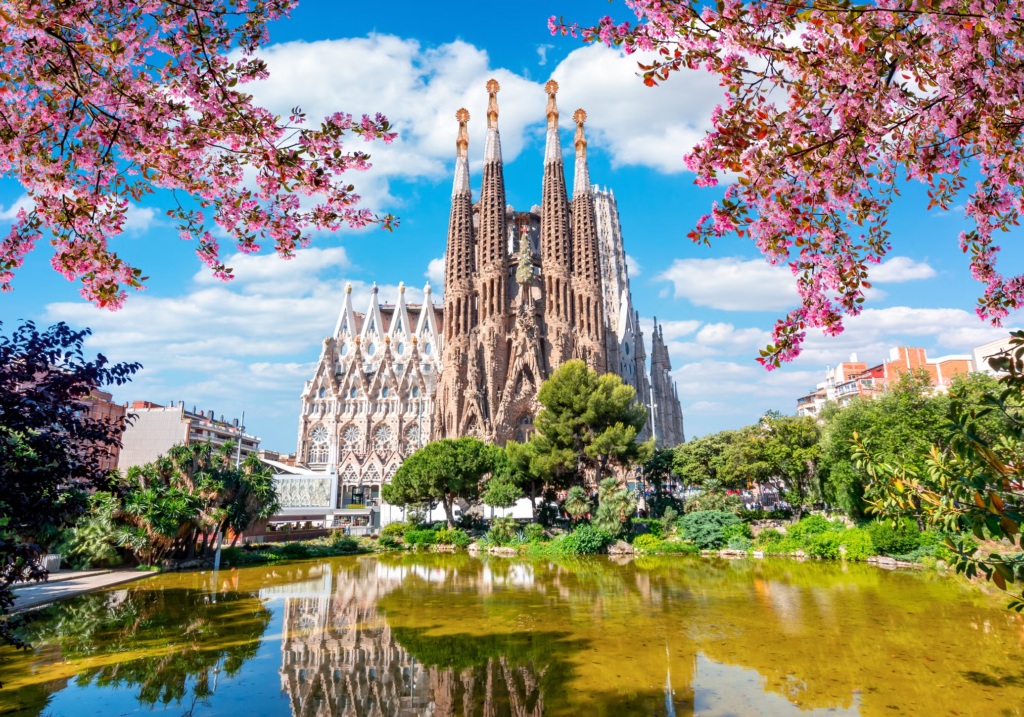Spain is a country rich in history, culture, and natural beauty. From the sun-drenched Mediterranean beaches to the lush, green hills of the north, and from bustling cities to charming villages, Spain has something for every traveler. If you’re planning a trip to this captivating country, you’ll want to make sure you visit its most iconic and interesting cities. Here’s a detailed look at the top 6 best cities to visit in Spain, complete with information on attractions, prices, and travel tips.
1. Barcelona

Barcelona, the capital of Catalonia, is one of Spain’s most visited cities. Famous for its unique blend of Gothic and modernist architecture, this coastal gem has a reputation for artistic innovation, dynamic nightlife, and a world-class culinary scene.
- La Sagrada Família: This basilica, designed by Antoni Gaudí, is an architectural masterpiece and a UNESCO World Heritage site. Entrance costs around €26, with guided tours starting from €40.
- Park Güell: Another Gaudí creation, Park Güell is a vibrant public park filled with colorful mosaics and architectural wonders. Entrance fees are €10.
- La Rambla: This famous street is lined with shops, restaurants, and performers, offering a lively atmosphere day and night.
Hotels in Barcelona range from budget-friendly to luxury. On average, a mid-range hotel will cost you about €80-€150 per night. Backpackers can find hostels for around €20-€40 per night.
Travel Tips:
- Barcelona is known for its pickpockets, especially in tourist areas like La Rambla, so keep an eye on your belongings.
- Public transportation is efficient, with a single metro ticket costing €2.40. If you’re staying longer, consider the 10-trip card for €11.35.
Read also: How to Avoid Tourist Scammers in Spain
2. Madrid

Madrid, the capital of Spain, is a bustling metropolis known for its royal palaces, world-class museums, and vibrant plazas. The city combines historical charm with modern vibrancy, making it a must-visit destination for any traveler to Spain.
- The Royal Palace: The official residence of the Spanish royal family, this palace is a stunning example of Baroque architecture. Entrance fees are €12.
- Prado Museum: One of the most famous art museums in the world, the Prado houses masterpieces from Goya, Velázquez, and other iconic artists. Tickets cost around €15.
- Retiro Park: A large, tranquil park where you can rent a boat and row around the lake or explore the gardens.
Madrid offers accommodation options for all budgets. A standard hotel room can range from €70 to €130 per night, while hostels average €15-€30 per night.
Travel Tips:
- Madrid’s public transport is excellent. The metro system is one of the largest in Europe, with a single ride costing €1.50-€2.00, depending on the distance.
- If you plan to visit multiple museums, consider the Paseo del Arte Card, which provides access to three major art museums (Prado, Reina Sofia, and Thyssen-Bornemisza) for €29.60.
3. Seville

Seville is the capital of the Andalusia region in southern Spain, known for its flamenco music, Moorish architecture, and festive atmosphere. This sun-soaked city is the epitome of Spanish culture and tradition.
- Seville Cathedral: The largest Gothic cathedral in the world and a UNESCO World Heritage site. Entrance is €10, with a chance to climb the Giralda Tower for panoramic views.
- Alcázar of Seville: This royal palace, with its stunning gardens and Moorish architecture, is one of the most beautiful sites in Spain. Tickets are priced at €14.50.
- Plaza de España: A massive, semi-circular plaza built for the 1929 Ibero-American Exposition, featuring stunning tile work and canals.
Seville offers a range of accommodations, from luxury hotels to budget-friendly guesthouses. On average, a mid-range hotel room costs €70-€120 per night. For budget travelers, hostels are available from €15-€30 per night.
Travel Tips:
- Seville can get extremely hot in the summer, with temperatures often exceeding 40°C (104°F). Spring and autumn are the best times to visit.
- The public bus system in Seville is reliable, with a single journey costing around €1.40.
4. Granada

Granada, located at the foot of the Sierra Nevada mountains, is famous for its mix of Islamic and Christian architecture. This city was the last stronghold of the Moors in Spain, and its historic influence is still evident today.
- The Alhambra: A stunning palace and fortress complex, the Alhambra is one of the most visited attractions in Spain. Entrance costs €14, but it’s recommended to book tickets well in advance due to high demand.
- Generalife Gardens: Adjacent to the Alhambra, these lush gardens offer a peaceful escape with spectacular views of the surrounding area. Entry is included with Alhambra tickets.
- Albaicín: The old Moorish quarter of Granada, characterized by its narrow streets, whitewashed buildings, and stunning views of the Alhambra.
Accommodation in Granada is generally affordable, with mid-range hotels costing around €60-€100 per night. Hostels are available from €12-€25 per night.
Travel Tips:
- Granada is a relatively small city, so walking is often the best way to get around.
- The city offers free tapas with every drink in most bars, so you can experience the local cuisine without breaking the bank.
5. Valencia

Valencia, located on Spain’s southeastern coast, is a city that perfectly blends its historical roots with modern innovation. Known for its futuristic architecture, golden beaches, and delicious paella, Valencia is a city that appeals to all types of travelers.
- City of Arts and Sciences: A futuristic complex that includes a planetarium, an opera house, a science museum, and Europe’s largest aquarium. Prices vary, with a combo ticket for multiple attractions costing around €38.
- Valencia Cathedral: This Gothic cathedral is said to house the Holy Grail, making it a must-visit for history buffs. Entrance is €8.
- Malvarrosa Beach: A beautiful urban beach with golden sands and calm waters, perfect for sunbathing and swimming.
Hotels in Valencia are reasonably priced, with mid-range options costing between €70-€120 per night. Hostels can be found for around €15-€30 per night.
Travel Tips:
- Valencia’s public transport system includes buses, trams, and metro lines, with single tickets costing €1.50. A 10-trip pass is €8.50.
- The city is known for its annual Las Fallas festival in March, which features massive papier-mâché sculptures that are burned in a spectacular display. If you plan to visit during this time, book your accommodation well in advance.
6. Bilbao

Bilbao, located in Spain’s Basque Country, is a city that has undergone a dramatic transformation in recent years. Once an industrial hub, Bilbao is now a thriving cultural center, home to world-class museums, innovative architecture, and a unique Basque culture.
- Guggenheim Museum: This iconic museum, designed by architect Frank Gehry, is a work of art in itself. Inside, you’ll find contemporary art from around the world. Tickets cost €16.
- Casco Viejo: The old town of Bilbao is filled with narrow streets, colorful buildings, and lively pintxos bars. It’s the perfect place to experience Basque cuisine.
- Zubizuri Bridge: A futuristic white footbridge that offers great views of the river and the surrounding city.
Bilbao offers a range of accommodations, with mid-range hotels costing €80-€140 per night. Budget travelers can find hostels from €20-€35 per night.
Travel Tips:
- Bilbao is known for its pintxos, the Basque version of tapas. A night of bar hopping and sampling pintxos is a must-do activity.
- The Basque language is spoken alongside Spanish in Bilbao, but don’t worry—most locals also speak English, especially in tourist areas.
As a traveler, it’s important to plan ahead, especially during peak tourist seasons. By understanding the cost of attractions, accommodation, and transportation, you can ensure that your visit to Spain is both enjoyable and affordable.








